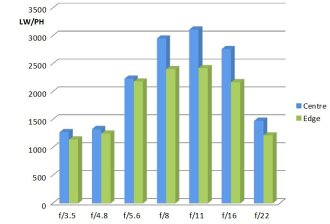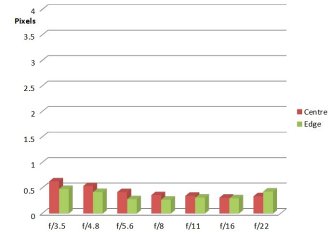Meike 8mm f/3.5 Fisheye Lens Review
Meike 8mm f/3.5 Fisheye Performance
Sharpness is a surprise strength of the design, when stopped down. We start off centrally with just a fair standard of sharpness, from f/3.5 to f/4.8. But at f/5.6 this rises to excellent and becomes outstanding at f/8 and f/11. f/16 is excellent and results are still good at f/22.
At the edges of the APS-C field f/3.5 and f/4.8 are fairly sharp only, this rising to very good at f/5.6 and excellent at f/8 and f/11. Still very good at f/16, sharpness then falls to fair at f/22.
How to read our charts
The blue column represents readings from the centre of the picture frame at the various apertures and the green is from the edges.The scale on the left side is an indication of actual image resolution as LW/PH and is described in detail above. The taller the column, the better the lens performance.
For this review, the lens was tested on a Nikon D810 using Imatest.
CA (Chromatic Aberration) is actually very reasonable for a fisheye lens. It can be seen at the corners of the image in particular, but at the edges control is still very good. Once we reach the outer limits though, such as the circular crop of a full frame camera, then the outer circle edge is a wide band of bright purple fringing. This does not impinge on the APS-C image field.
How to read our charts
Chromatic aberration is the lens' inability to focus on the sensor or film all colours of visible light at the same point. Severe chromatic aberration gives a noticeable fringing or a halo effect around sharp edges within the picture. It can be cured in software.Apochromatic lenses have special lens elements (aspheric, extra-low dispersion etc) to minimise the problem, hence they usually cost more.
For this review, the lens was tested on a Nikon D810 using Imatest.
As the lens hood fits so badly, it is fortunate indeed that the resistance to flare is amazing. Even with the sun in the frame, through trees, there is no sign of a loss of contrast or of unwanted artefacts.
All fisheye lenses, by their very nature, have excessive amounts of barrel distortion. If they didn't we would be asking for a refund. The Meike 8mm bends lines beautifully and Imatest was defeated and unable to cope with the excessive distortion. So there is no distortion figure, suffice it so say that the lens delivers as expected.
The manufacturers claim beautiful bokeh for the lens, and it is true that the out of focus areas, such as they are, have a pleasant enough quality. However, so much is in focus that the effect is not as strongly seen as it would be in longer lenses.
Overall, the performance of the lens is very satisfactory.
Value For Money
The Meike 8mm f/3.5 Fisheye lens is currently priced at $199, which would currently equate to around £165. An obvious alternative would be the previously tested Kelda 8mm f/3.5 Fisheye (around $180) or the Samyang 8mm f/3.5 UMC CS II fisheye lens at £259.
When we cast the net wider, there is a dazzling array of fisheye lenses, both frame filling designs and circular image designs.
Those throwing a proper circular image (not cut off as in the Meike) include the Sigma 4.5mm f/2.8 EX DC HSM Circular (£599) and the Lensbaby Circular Fisheye (£259).
Frame filling lenses, almost all designed for smaller formats such as APS-C or MFT, include the Sigma 10mm f/2.8 EX DC HSM Diagonal (£479), Sigma 15mm f/2.8 EX DG (£499), Nikon AF 10.5mm f/2.8 G IF-ED (£585), Sony 16mm f/2.8 (£799), Olympus M.Zuiko Digital 8mm f/1.8 PRO (£799).
There are also numerous fisheye zooms, body cap fisheye lenses and front lens converters, plus, for the diminutive Pentax Q system, the SMC Pentax 3.2mm f/5.6 at £79.
Amongst all this, the Meike has to be seen as good value, a relatively inexpensive way to acquire a fisheye lens that is capable of impressive results.
Add your message
Please login here or if you've not registered, you can register here. Registering is safe, quick and free.
photodo Stats
428 MTF tests
74 in-depth photodo reviews
100+ users join each day
Help the lens community by reviewing or rating a lens today via our lens search
Latest Lens Reviews
- Chinon 28mm f/2.8 Vintage Lens Review
- Canon EF 70-200mm f/4L IS II USM Lens Review
- Samyang AF 85mm f/1.4 EF Review
- Sigma 70mm f/2.8 DG Macro Art Review
- Samyang AF 24mm f/2.8 FE Review
- Meike 50mm f/1.7 Review
- Tamron 70-210mm f/4 Di VC USD Review
- Lensbaby Burnside 35mm f/2.8 Review
- Asahi Super Takumar 50mm f/1.4 Review
- Asahi Super-Multi-Coated Takumar 135mm f/3.5 Review


